| ________________
CM . . . . Volume XVII Number 38 . . . . June 3, 2011

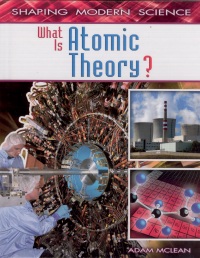 |
What Is Atomic Theory? (Shaping Modern Science).
Adam McLean.
St. Catharines, ON: Crabtree, 2011.
64 pp., pbk. & hc., $12.95 (pbk.), $22.36 (RLB.).
ISBN 978-0-7787-7204-0 (pbk.), ISBN 978-0-7787-7197-5 (RLB).
Subject Heading:
Atomic theory-Juvenile literature.
Grades 5-8 / Ages 10-13.
Review by Barbara McMillan.
***1/2 /4
|
| |
|
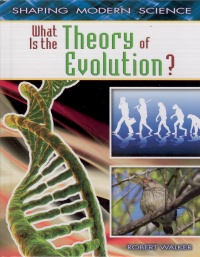 |
What Is the Theory of Evolution? (Shaping Modern Science).
Robert Walker.
St. Catharines, ON: Crabtree, 2011.
64 pp., pbk. & hc., $12.95 (pbk.), $22.36 (RLB.).
ISBN 978-0-7787-7205-7 (pbk.), ISBN 978-0-7787-7198-2 (RLB).
Subject Heading:
Evolution-Juvenile literature.
Grades 5-8 / Ages 10-13.
Review by Barbara McMillan.
***1/2 /4 |
| |
|
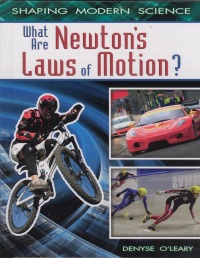 |
What Are Newton’s Laws of Motion? (Shaping Modern Science).
Denyse O’Leary.
St. Catharines, ON: Crabtree, 2011.
64 pp., pbk. & hc., $12.95 (pbk.), $22.36 (RLB.).
ISBN 978-0-7787-7207-1 (pbk.), ISBN 978-0-7787-7200-2 (RLB).
Subject Headings:
Newton, Isaac, Sir, 1642-1727-Juvenile literature.
Motion-Juvenile literature.
Gravity-Juvenile literature.
Grades 5-8 / Ages 10-13.
Review by Barbara McMillan.
***1/2 /4 |
| |
|
 |
What Is Germ Theory? (Shaping Modern Science).
Natalie Hyde.
St. Catharines, ON: Crabtree, 2011.
64 pp., pbk. & hc., $12.95 (pbk.), $22.36 (RLB.).
ISBN 978-0-7787-7208-8 (pbk.), ISBN 978-0-7787-7201-9 (RLB).
Subject Heading:
Germ theory of disease-Juvenile literature.
Grades 5-8 / Ages 10-13.
Barbara McMillan.
***1/2 /4 |
| |
|
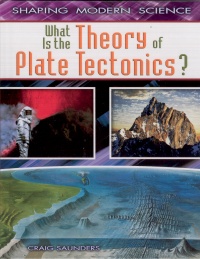 |
What Is the Theory of Plate Tectonics? (Shaping Modern Science).
Craig Saunders.
St. Catharines, ON: Crabtree, 2011.
64 pp., pbk. & hc., $12.95 (pbk.), $22.36 (RLB.).
ISBN 978-0-7787-7209-5 (pbk.), ISBN 978-0-7787-7202-6 (RLB).
Subject Headings:
Plate tectonics-Juvenile literature.
Geology, Structural-juvenile literature.
Grades 5-8 / Ages 10-13.
Review by Barbara McMillan.
***1/2 /4 |
| |
|
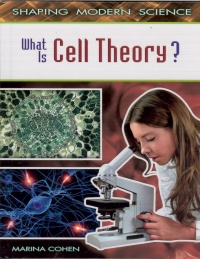 |
What Is Cell Theory? (Shaping Modern Science).
Marina Cohen.
St. Catharines, ON: Crabtree, 2011.
64 pp., pbk. & hc., $12.95 (pbk.), $22.36 (RLB.).
ISBN 978-0-7787-7206-4 (pbk.), ISBN 978-0-7787-7199-9 (RLB).
Subject Headings:
Cells-Juvenile literature.
Cytology-Juvenile literature.
Grades 5-8 / Ages 10-13.
Review by Barbara McMillan.
***1/2 /4 |
| |
|

excerpt:
About 2,500 years ago, people began to ask important questions about motion. A question like, “Why do things fall down and not up?” may seem silly. It is not a silly question at all, though. Something causes them to fall. What is that something? Science is about asking these kinds of questions. (From What Are Newton’s Laws of Motion?)
In science, a theory is a well-tested set of ideas that explains how something occurs. For example, many kinds of evidence together support the Theory of Plate Tectonics. (From What is the Theory of Plate Tectonics?)
The theory of evolution is one of the most important areas of research and study in nature. It provides an explanation for how the amazing diversity of life on Earth could come from simple single-celled organisms, and for how life forms change over time in response to their environments. (From What Is the Theory of Evolution?)
Today we know that all living things on Earth are made up of very tiny parts. These parts are called cells. Cells are the building blocks of life. Every living thing – from turtles to trees, cherries to chickens – is made up of cells. All new cells come from cells that already exist. This, essentially, is what the Cell Theory is all about. (From What Is Cell Theory?)
Once scientists were able to look in a microscope and see germs, they learned something astonishing: germs are everywhere! They are on and in everything on Earth: plants, animals, humans, soil, air, and water. Some germs are very dangerous and cause disease. But 95 percent of al germs are harmless. They are actually vital to our health and the health of our planet. (From What is Germ Theory?)
Atomic theory describes the structure and function of matter: For example, it describes why diamond is the hardest material, while mercury – a metal like all other metals – is liquid at room temperature. Atomic theory also explains the nuclear forces that hold atoms together and electric forces that keep atoms apart. (From What Is Atomic Theory?)
I began my reading of the Crabtree series “Shaping Modern Science” by selecting Marina Cohen’s What Is Cell Theory? Of the five theories and the laws of motion described in this series, cell theory is the one that I knew most about. I was hooked before Chapter 1 began. In the introductory pages, Cohen distinguishes a scientific theory from a scientific law and begins to answer the question, “What is cell theory?” In so doing, she includes a quote from Albert Claude, a cytologist and Nobel Laureate who first became aware of the fine structure of the cell, and then she briefly describes the work of Theodor Schwann, Matthias Schleiden, and Rudolph Virchow who are known as the originators and developers of cell theory. The book continues with seven chapters.
Chapter 1 looks at the development of lenses and the microscope and what this instrument enabled microscopists, like Marcello Malphigi, Robert Hooke, Antonie van Leeuwenhoek, to see (e.g., pulmonary capillaries, plant cells, and unicellular organisms moving in water, respectively). Cohen makes the point that it was the work of Hooke and Leewenhoek in the mid-1600s that paved the way for Schleiden, Schwan, and Vichow’s work in the 1800s.
The focus of Chapter 2 is the cell, the difference between a prokaryotic cell and an eukaryotic cell, the size of cells, the organelles found in both plant and animal cells, and the function of these “little organs”. Chapter 3 describes in more detail the work that led to the development of cell theory, with particular emphasis on the third principle of the theory, namely: “All cells come from other cells that grow and divide.” Readers learn about spontaneous generation, Pasteur’s work that showed life comes from life not non-living matter, and the phases of cell division, specifically mitosis. The focus of Chapter 4 is the impact of cell theory on our understanding of disease, evolution, and heredity. The final three chapters look specifically at the different cell types in the human body, the chromosomal theory of inheritance, and modern cell theory that rightly includes information on cloning and genetic engineering. As in the previous chapters, the important researchers in these areas are mentioned and their work is briefly described.
I’m not certain if my engagement with what Cohen has presented in What Is Cell Theory? is a consequence of my interest in the history of science and how this history can begin to help learners understand the nature of science. It could also be the result of my age and wanting to know more about the naturalists and scientists that were often relegated to side bars or one-to-two lines in the textbooks I once read for courses in cell biology, microbiology, biochemistry, genetics, and microscopy. What I do know is that this book and the series in which it is included make a very good contribution to the resources for Grades 5 to 10 that present science from a more humanistic perspective and within a context that is historical. Such an approach to science learning is known to appeal to those students who identify more with the humanities than the sciences.
Each book in the series, regardless of the theory or laws featured, follows the format described above. After the table of contents, there is an introduction that is followed by seven chapters that include topics similar to the topics addressed in Cohen’s book: what the theory is about, prehistory, scientific evidence, origin of the theory or laws, impact of the theory or laws, and “cutting edge” research. All six books end with a two-page timeline, glossary, a list of books and websites “for more information”, and an index. The layout and design of the books in the series are also similar, and even though the colour of the cover and page borders is unique to each book, the pattern of the border does not change. Stock photographs and images in the public domain are used to illustrate what the author describes or makes reference to. The design firm, First Image, and project coordinator, Kathy Middleton, have also chosen to incorporate text boxes, direct quotes in a blue, script-like font, and “quick facts” that are printed on the lens of a handheld magnifying glass.
In Manitoba, one of the provinces whose curricula for science were based upon the “Pan-Canadian Common Framework of Science Learning Outcomes”, it is possible to identify the grade level where the contents of the books are best suited. These are as follows:
Grade 7, Cluster 4: Earth’s Curst aligns with What Is Plate Tectonics?
Grade 8, Cluster 1: Cells and Systems aligns with What Is Cell Theory?
Grade 9 (Senior 1), Cluster 2: Atoms and Elements aligns with What Is Atomic Theory?
Grade 10 (Senior 2), Cluster 3: In Motion aligns with What Are Newton’s Laws of Motion?
Grade 12 (Senior 4), Biology, Part 2, Biodiversity, Unit 3, Evolutionary Theory and Biodiversity aligns with What Is the Theory of Evolution?
Two items are worth mentioning in light of this information. First, germ theory does not appear as an explicit science-learning outcome. It may, however, be a component of the middle years or senior years health curricula. Second, three of the books address topics that are beyond the grade levels for which the series was written. At the senior years level, teachers and their students would certainly expect a deeper and more scientific approach to the historical content. For these reasons, although the individual books are highly recommended, I suggest that teachers and librarians select specific titles rather than purchasing the entire “Shaping Modern Science” series.
Highly Recommended.
Barbara McMillan is a teacher educator and a professor of science education in the Faculty of Education, the University of Manitoba.

To comment
on this title or this review, send mail to cm@umanitoba.ca.
Copyright © the Manitoba Library Association. Reproduction for personal
use is permitted only if this copyright notice is maintained. Any
other reproduction is prohibited without permission.
NEXT REVIEW |
TABLE OF CONTENTS FOR THIS ISSUE
- June 3, 2011.
AUTHORS |
TITLES |
MEDIA REVIEWS |
PROFILES |
BACK ISSUES |
SEARCH |
CMARCHIVE |
HOME |





